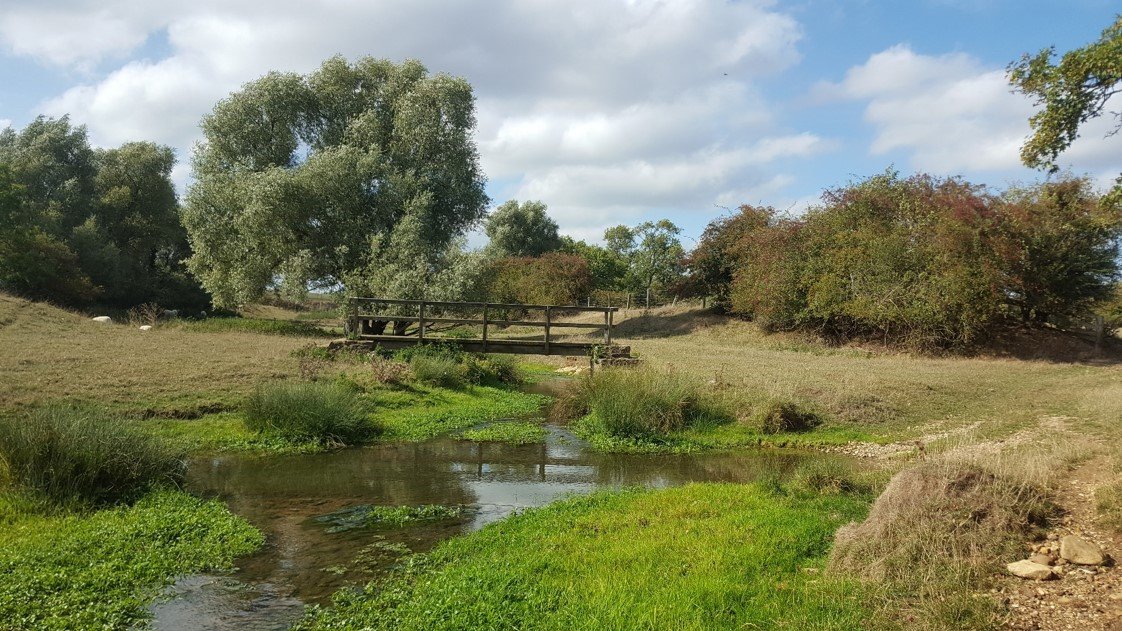Nature inspires a flood alleviation solution
1st November 2019
A Natural Flood Management scheme on the River Leck, designed to work with nature by emulating naturally occurring woody debris, could help protect a north Buckinghamshire community at risk of flooding from a swollen river.

Twenty five ‘leaky dams’ are being built in the headwaters of the River Leck, a tributary of the River Great Ouse north of Buckingham, to store and slow the water during heavy rain to reduce flood risks downstream. Buckinghamshire County Council’s Flood Management Team commissioned Freshwater Habitats Trust to oversee installation of the dams during summer 2019, and now, with the onset of the autumn rain we are starting to see them working in practice.

When they are all built, it is predicted that the dams should alleviate peak river flows by up to 10%. This, says Bill Chapple OBE, Cabinet Member for Planning and Environment, will help protect downstream communities, such as Leckhampstead, from the risk of flooding.
The leaky dams scheme – a ‘first’ for Buckinghamshire and one of the first for lowland southern England – will be monitored in partnership with landowners during the next couple of years to measure their effectiveness, with a view to replicating it in other parts of the county.
The project was developed in consultation with the local community and local landowners. A feasibility study to assess the opportunities for Natural Flood Management and computer models predicting how much water would be held back during flood events were prepared by JBA Consulting.

Design and oversight has been led by Peter Case of Freshwater Habitats Trust and Andrew Waugh of the BCC Flood Management Team. The work builds on a major research demonstration project in Leicestershire called Water Friendly Farming, run jointly by Freshwater Habitats Trust, the Allerton Project of the Game & Wildlife Conservation Trust, the University of York and the Environment Agency.
Through Water Friendly Farming we’ve found that these structures are highly effective at holding back considerable volumes of water (up to 500 cubic metres per dam in our test catchments). Dams set above the height of the bank top, often with extending wing walls can push flood water on to the floodplain, reconnecting and linking depressions (runoff attenuation features) and creating capacity. Although these large structures may look at a complete barrier to fish and other stream wildlife, they are set at 300mm above base flows so in normal conditions the river is unaffected.
The work on the Leck is one of the first practical examples of Natural Flood Management to be completed in lowland southern England. The scheme is truly a local enterprise, working with four landowners, one of whom provided the timber for the project for free, and former local farm manager David Gowton who now runs Escapes, the agricultural and landscaping contractor, who has been handling the construction.
As this is a pilot project we are keen to undertake monitoring to assess the effectiveness of the dams under low and high flow conditions. Monitoring is often overlooked and can be prohibitively expensive. The Leck project comes with its own creative technological monitoring solution, designed and installed by AmbioTEK; a solar-powered monitoring system in the form of converted car reversing sensors that detect rising river levels and measure how much water the dams will hold back.

Leckhampstead Parish Council are fully behind the scheme. Parish Councillor, Richard Gurney said, “After working with Andrew Waugh from the County Council and Peter Case from Freshwater Habitats Trust for over three years, it’s great that we will finally have 25 of these impressive dams in place ahead of the planned schedule and we are confident that this will reduce the flooding risk to those village properties that have been affected in the past”.
“The Parish Council extends its thanks to their parish neighbours and the landowners for enabling this project. Being the first such project in Buckinghamshire, will also mean Leckhampstead will be providing an example of the potential for other such projects in the future.”
One of the key landowners, Oliver Robarts of the Tile House Estate, commented, “With the excellent support of the Freshwater Habitats Trust, the Tile House Estate is very fortunate to be able to help contribute to flood risk reduction on downstream communities. The innovative combination of natural flood defences, ‘leaky dams’ and the high-tech monitoring stations will no doubt prove to have a beneficial impact on downstream flooding and the wider environmental concerns.”

The scheme is being funded by a £50,000 award from the Department for the Environment, Farming and Rural Affairs secured by the County Council’s Flood Management Team, and £35,000 from the County Council’s flood management budget.
